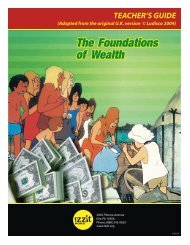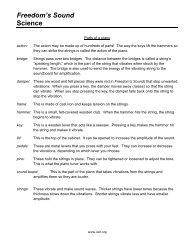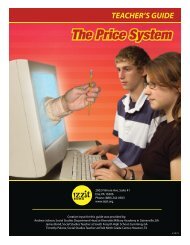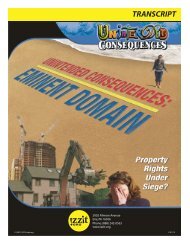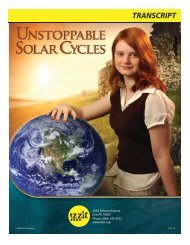Transcript - Izzit.org
Transcript - Izzit.org
Transcript - Izzit.org
Create successful ePaper yourself
Turn your PDF publications into a flip-book with our unique Google optimized e-Paper software.
WOMAN: …and eventually there was the energy of coal…<br />
MAN: …and the energy of oil…<br />
WOMAN: …and linking these sources of energy to our mechanical devices meant that we could till soil,<br />
draw water, grind corn and produce all kinds of things far more quickly- than by simply using our own<br />
muscles.<br />
MAN: Mechanization was the second step out of the subsistence economy. We mechanized by inventing<br />
devices, and by using natural forces to add to our own efforts. And it was specialization and<br />
mechanization that gave us our surplus.<br />
WOMAN: But what is the surplus What is it that specialization and mechanization gave us<br />
MAN: First, we now have stores of food that will last us through the winter. We have a few luxuries to<br />
tide us over until the harvest.<br />
WOMAN: Second, we have surplus food and manufactured goods that we can exchange for other things<br />
we want when the trader brings them.<br />
MAN: Third, we built a bridge and a barn and a waterwheel, we dug irrigation channels. We made<br />
spinning wheels and plows- and they help us protect or even increase our prosperity.<br />
WOMAN: Fourth, we can spare one or two people from the field to serve the rest. Parts of the surplus<br />
food can go to someone who teaches the children, and somebody who looks after the sick.<br />
MAN: And fifth, we have a bit of time to spare. We can play games occasionally, paint beautiful<br />
pictures on our crockery, or make beautiful clay figures or decorate our huts. So, we applied our surplus<br />
to five different things: reserves (in this case food), trade, capital, services and leisure.<br />
WOMAN: All this may not seem much if you don’t remember how they started out in a subsistence<br />
economy.<br />
MAN: I’ll never f<strong>org</strong>et it – days of cold, sickness, hunger – days of backbreaking toil…<br />
WOMAN: It all seems a long way away now.<br />
MAN: Yes, we have come a long way.<br />
WOMAN: Yeah. Of course, I don’t really have to tell you that our community is imaginary. A valley<br />
like ours never really existed.<br />
MAN: Not exactly, anyway. But everything we’ve seen, everything we’ve talked about, really happened<br />
through the ages in some community or another. Let’s take a look at reality for a minute.<br />
WOMAN: This is how men once tried to set down their own reality. These are the actual pictures drawn<br />
by primitive men showing their own lives as hunters and wanderers.<br />
22




